When it comes to steak, two of the most popular cuts are the ribeye and the striploin. Both of these steaks come from the same primal cut – the short loin – and offer a great flavor experience for steak lovers. But, ribeye vs striploin – which one should you choose? To help you decide, we’ll closely examine the ribeye and striploin steaks, including their taste, texture, cost, and cooking methods. By comparing these two cuts, you can determine which best suits your tastes and preferences. So let’s dive right in!
What is Ribeye?
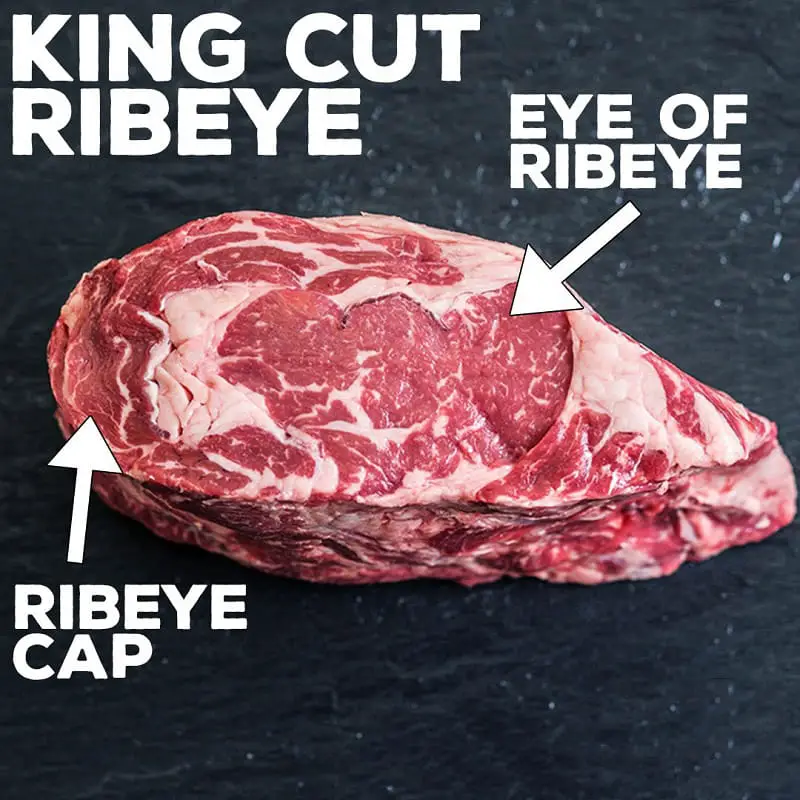
Ribeye is one of my favorite cuts of meat. It is a beef cut from the cow’s rib section. It is known for its rich flavor and tenderness, making it a popular choice for steak lovers worldwide.
What makes ribeye so special is the marbling, or fat content, that runs through the meat. This marbling not only adds flavor but also enhances the tenderness of the steak. When cooked correctly, the fat will melt and baste the meat, creating a juicy and flavorful steak.
Ribeye can be cooked in various ways, from grilling to pan-searing or even sous vide. However, it is important to note that ribeye is best cooked to medium-rare or medium doneness to enjoy its flavor and tenderness fully.
When ordering a ribeye at a restaurant, you may see different names, such as “cowboy ribeye” or “tomahawk ribeye.” These names refer to the specific cut of the ribeye and how it is presented with the bone attached.
In terms of nutrition, ribeye is a good source of protein and iron. However, due to its high-fat content, it is essential to enjoy it in moderation as part of a balanced diet.
Ribeye is a delicious and popular cut of beef that any meat lover should try at least once. Whether cooked at home or enjoyed at a restaurant, a perfectly cooked ribeye is a treat for the taste buds.
What is Striploin?
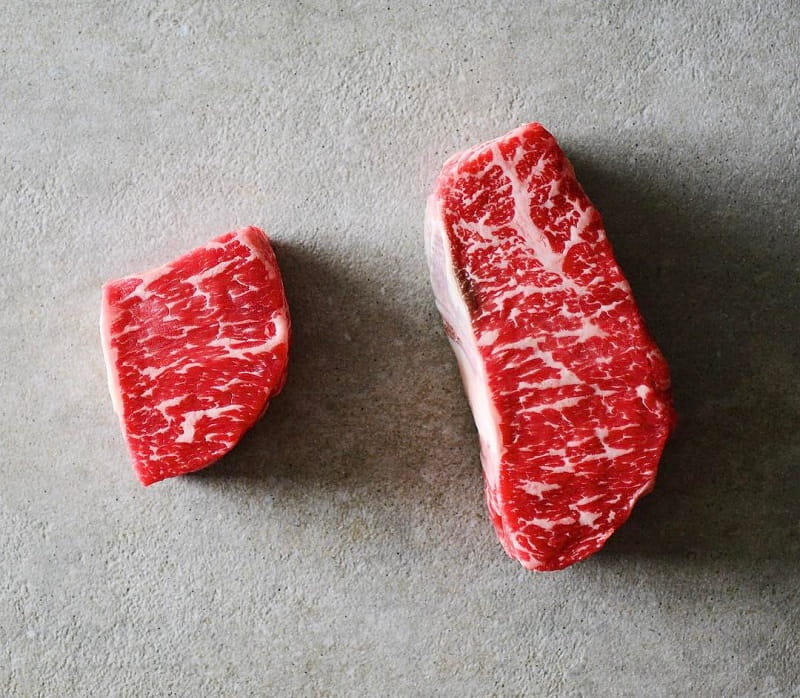
Striploin is a delicious and flavorful cut of beef that deserves more recognition. It is a cut of beef that comes from the short loin of the cow, which is located in the middle of the back. It is also known as the New York strip, Kansas City strip, or top loin. The striploin is a lean cut of meat with a nice marbling of fat that adds flavor and juiciness to the meat.
One thing that sets striploin apart from other cuts of beef is its tenderness. It is not as tender as filet mignon but still very tender and easy to eat. This makes it an excellent choice for grilling or pan-searing, as it cooks quickly and evenly.
Another great thing about striploin is its flavor. It has a rich, beefy flavor that is often described as slightly nutty or buttery. This flavor comes from the marbling of fat in the meat, which melts and infuses the beef with delicious flavor as it cooks.
There are a few things to keep in mind when it comes to cooking striploin. First, it is important to let the meat come to room temperature before cooking it. This will help it cook more evenly and prevent it from becoming tough. Second, it is best to season the meat with just salt and pepper to let the natural flavor of the beef shine through. Finally, letting the meat rest for a few minutes after cooking is important to allow the juices to redistribute and create a more tender and juicy steak.
In conclusion, striploin is a delicious and flavorful cut of beef that is perfect for anyone who loves a good steak. It’s tenderness and rich flavor make it a great choice for grilling or pan-searing, and it is sure to impress anyone who tries it.
Ribeye And Striploin: What’re The Similarities
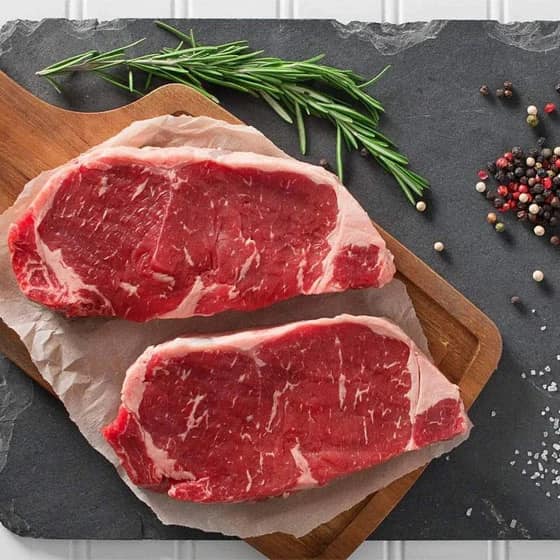
Ribeye and Striploin are two popular cuts of beef that meat enthusiasts worldwide love. While these cuts differ in flavor, fat content, and texture, they also share similarities.
- Firstly, both Ribeye and Striploin are prized for their tenderness. These cuts come from areas of the cow that have less muscle usage, making the meat less tough and more succulent.
- Secondly, Ribeye and Striploin are known for their rich, beefy flavor. This is due to the high-quality marbling found in these cuts, which provides a depth of flavor that is hard to beat.
- Thirdly, both Ribeye and Striploin are versatile cuts that can be cooked in various ways. Whether grilled, roasted, or pan-fried, these cuts can be prepared to suit individual tastes and preferences.
In conclusion, while Ribeye and Striploin may differ in some respects, they share many qualities that make them sought-after cuts of beef. Whether you are a fan of one or both, these cuts offer a delicious and satisfying dining experience.
What Is The Difference Between Ribeye vs Striploin
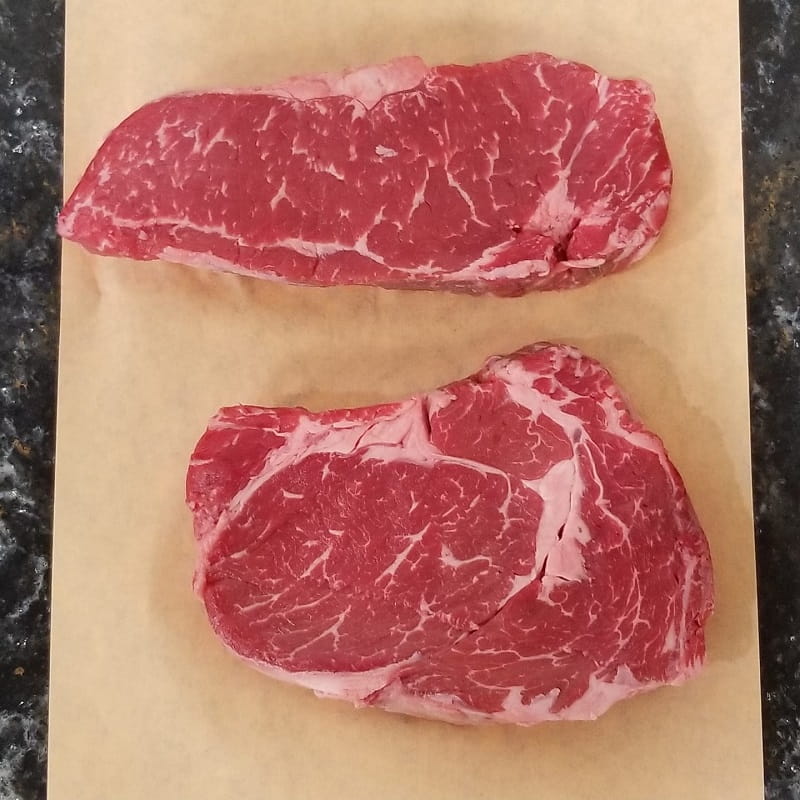
Both of these cuts come from the same region of the cow, the short loin, but they have distinct differences. Ribeye is well-known for its high-fat content, giving it a rich and juicy flavor. Striploin, on the other hand, is slightly leaner and has a more pronounced beefy flavor. Striploin is also a little less expensive than ribeye, making it a more affordable option. However, ribeye is popular for its tenderness and flavor, making it a favorite among steak lovers.
Both cuts can be prepared using various cooking methods, such as grilling or pan-searing, and enjoyed in various dishes. Ultimately, the difference between ribeye and striploin comes down to personal preference, but knowing the characteristics of each can help inform your selection.
Origin
Ribeye steak comes from the cow’s rib section, specifically the upper rib cage or, commonly referred to, the “cowboy” steak in the United States. It is known for its fatty marbling that is evenly distributed throughout the meat, resulting in a flavorful and juicy steak. On the other hand, striploin steak comes from the loin section of the cow just above the round. It is the perfect combination of tenderloin and ribeye, boasting a melt-in-your-mouth texture experience and a potently “beefy” flavor. Unlike ribeye, striploin has a more even marbling distribution, resulting in a smoother texture.
Flavor Profiles
Ribeye is known for its abundantly marbled appearance and fatty marbling, which results in a juicy quality that is perfect for grilling. On the other hand, the striploin contains a more even distribution of marbling, resulting in a flavorsome steak with guaranteed tenderness. The striploin is a great middle ground between the tenderloin and ribeye, with a melt-in-your-mouth texture experience and a potently beefy flavor.
Which Steak Cut Has More Marbling?
The Ribeye has more marbling, making it a tender and flavorful cut. This also makes it more forgiving to cook, as the fat helps to keep it moist and delicious. The Striploin has less marbling and a tighter texture, making it a popular choice for those who prefer a bit of chew with their Steak.
Whether cooking a Ribeye or Striploin, look for at least one inch thick, choice or prime-grade cuts. Proper cooking techniques, such as grilling over a two-zone fire, can help to ensure a delicious and satisfying meal.
Read more:
Cooking Methods
In terms of cooking methods, the difference between ribeye and striploin is quite subtle. Both cuts of meat are best cooked with dry heat methods such as grilling, broiling, or pan-frying. However, due to the higher fat content of the rib eye, it tends to be more forgiving when it comes to cooking temperatures and times.
This means ribeye can be cooked to a higher temperature without becoming dry or tough. In contrast, striploin requires more attention during cooking to prevent it from becoming overcooked or leathery. That being said, striploin is still a versatile cut of meat that can be cooked to various temperatures to suit different preferences.
Ultimately, the best cooking method for ribeye and striploin depends on personal preference and the desired level of doneness. No matter how you cook either cut, just let them rest for a few minutes before serving to allow the juices to distribute evenly throughout the meat.
Ribeye vs Striploin: Fat Content
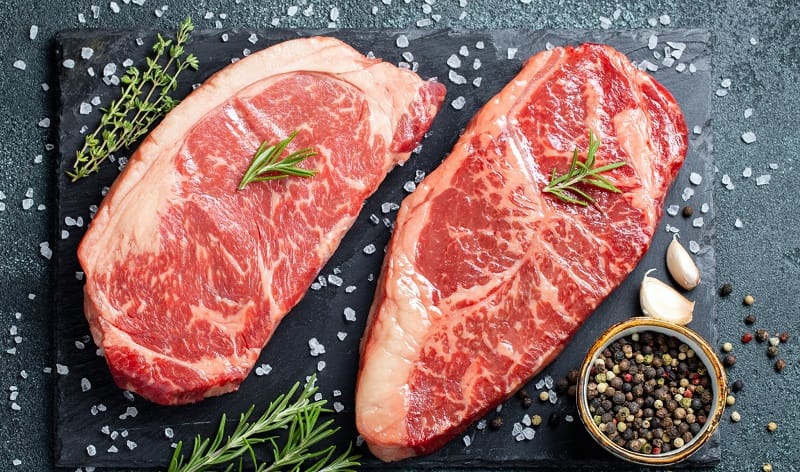
A ribeye steak is recognized for its high-fat content, resulting in a juicy and succulent flavor. On the other hand, a striploin steak is relatively leaner, making it a healthier option with less fat. For instance, a 3.5-ounce broiled ribeye steak contains approximately 15 grams of fat, while a similar serving of striploin steak contains under six grams of fat.
One’s preference for flavor and personal health goals should be considered when choosing between the two. While fat is an essential macronutrient, consuming excessive saturated fat can increase the risk of heart disease. It is worth noting that both ribeye and striploin steaks contain similar amounts of cholesterol. Nonetheless, both cuts are rich in protein, iron, zinc, selenium, and phosphorus, making them a healthy source of nutrition.
Nutritional Value
A ribeye steak has a higher fat content, with a 3.5-ounce serving to contain almost 15 grams of fat, compared to just under 6 grams in a striploin steak of the same size. Additionally, a ribeye contains more saturated fat, with 5.7 grams per serving, compared to 2.2 grams in a striploin.
Both steaks contain similar amounts of cholesterol, with a serving of ribeye containing 89 milligrams and a serving of striploin containing 82 milligrams. In terms of protein, both cuts are abundant, with a 3.5-ounce serving of ribeye containing about 27 grams and a serving of striploin containing about 31 grams.
Both steaks are high in minerals like phosphorus, zinc, iron, and selenium. However, regarding vitamins, ribeye steak is higher in niacin, vitamin B-6, and vitamin B-12, with a 3.5-ounce serving providing 50%, 44%, and 67% of the daily value for adults, respectively. On the other hand, a serving of striploin provides 42%, 38%, and 60% of the daily value for niacin, vitamin B-6, and vitamin B-12, respectively.
In conclusion, while ribeye and striploin steaks have nutritional benefits, ribeye contains higher amounts of fat and saturated fat. In contrast, striploin has more protein and is slightly higher in vitamins B2 and B6.
Popular Dishes
Ribeye, frequently referred to as “rib loin” or “cube roll” in different countries, is known for its finely marbled meat with even fat distribution. When cooked, it results in a rich and juicy beef flavor, making it perfect for dishes like steak, Korean barbecue, and roast beef. On the other hand, Striploin is a cut of meat condensed with red meat and juicy fat located just above the round. It is a versatile meat that goes well with any cooking method, making it ideal for steak and roast beef dishes.
In cooking delicious roast beef, the type of meat used is crucial. Imported Striploin is recommended for roast beef as it is leaner and less likely to become firm when cold. In contrast, roast beef made from Ribeye suits imported beef with more fat content. The fat content varies depending on the country of production, and American beef has the least fat, while Australian beef has somewhat more, and New Zealand beef lies between them.
Which Cut Is Generally Considered More Tender – Ribeye Or Striploin?
Ribeye steak has high amounts of intramuscular fat, which makes it more tender and juicy. It also boasts a distinct flavor due to the fatty marbling throughout the meat. Striploin steak, conversely, has a more even fat distribution and is known for its melt-in-your-mouth texture. This makes it popular among steak lovers who prefer a more tender and less fatty cut. Both cuts are delicious and satisfying, and it’s up to the individual to decide which is more suitable for their taste.
Striploin vs Ribeye: Price
For those wondering about the price differences between ribeye and striploin, it all comes down to supply and demand. Since ribeye is a more marbled cut and is typically considered more desirable, it tends to be priced higher than striploin. Additionally, the cost of ribeye can vary depending on the market and beef quality. On the other hand, striploin is a more affordable option that still offers great flavor and tenderness. However, just because it is priced lower does not mean it is of lower quality.
Presentation
When it comes to choosing between ribeye and striploin, it ultimately boils down to personal preference. Ribeye is well-known for its fatty marbling that results in a distinctively juicy quality and is an excellent steak cut for grilling. Striploin, on the other hand, is the perfect middle ground between the tenderloin and ribeye steak, boasting a melt-in-your-mouth texture experience with a potently ‘beefy’ flavor.
The main difference between the two cuts is that the striploin contains a more even distribution of marbling than the ribeye. The New York Strip and Ribeye are prime cuts, but noteworthy differences exist.
The New York Strip comes from the short loin subprimal part of the loin primal, which is tender and flavorful, while the ribeye comes from the rib primal and consists of the ribeye proper, rib cap, and complexus muscle. The thickness and size of each cut can vary, with New York strips typically cut to 1.5 to 2 inches thick, while some ribeyes can weigh up to 72 ounces or more.
Which Cut Of Steak Is Best For Grilling?
When choosing between ribeye and striploin cuts of steak for grilling, personal preference plays a significant role. A juicy and fatty steak like ribeye or a flavorsome and tender cut like striploin. It’s recommended to try both to decide the personal favorites.
Which Is Better – Striploin Or Ribeye Beef?
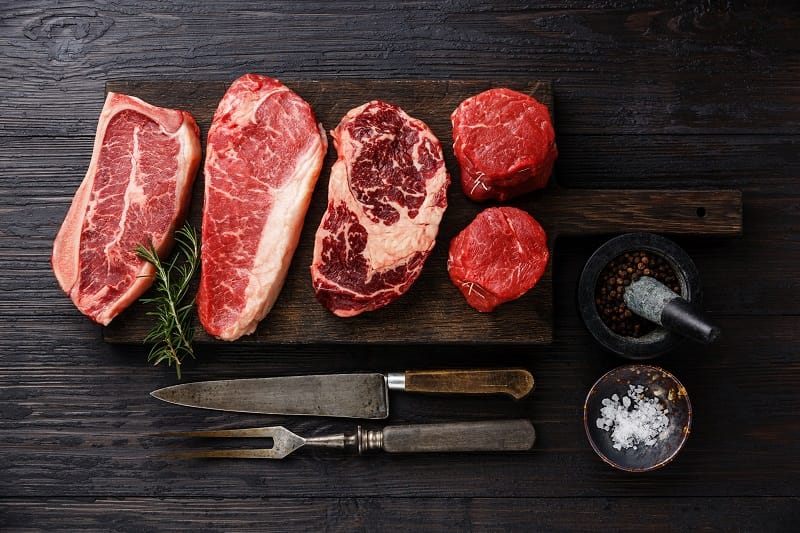
When deciding between ribeye and striploin, it all comes down to personal preference. The main difference between the two is that striploin contains a more even distribution of marbling throughout. If you prefer a juicy steak, ribeye may be your best bet, but striploin is the way to go if you want a flavorsome cut with guaranteed tenderness. At the end of the day, why choose? You can enjoy both cuts equally whenever the mood takes you.
Ribeye and striploin are popular meat cuts with unique characteristics, depending on the individual’s taste preferences.
What Are The Most Popular Accompaniments For Ribeye And Striploin Steaks?
The perfect accompaniment can make or break your steak experience. So, what are the most popular accompaniments for these beloved cuts of meat?
- First and foremost, let’s talk about the classic side dish: mashed potatoes. There’s just something about the creamy, buttery texture that complements a juicy steak so well. But don’t stop at plain old mashed potatoes – add some chives or garlic for an extra kick of flavor.
- Another popular option is grilled asparagus. The slightly charred flavor of the asparagus pairs perfectly with the rich taste of the steak. Plus, it’s a healthy vegetable option that won’t leave you feeling too guilty about indulging in a big, juicy steak.
- For those who prefer a bit of sweetness with their steak, roasted carrots are a great choice. The natural sweetness of the carrots pairs well with the savory taste of the steak, and the roasted texture adds a nice crunch.
- Now, let’s talk about sauces. A classic béarnaise sauce is a popular choice for steak lovers. Made with egg yolks, butter, and tarragon vinegar, this sauce adds a rich and creamy flavor to your steak. Alternatively, a red wine sauce can add a bold and tangy flavor to your meal.
- Last but not least, let’s not forget about the bread. A warm and crusty baguette can be the perfect addition to any steak dinner. Use it to soak up any leftover sauce or juices from your steak, or enjoy it as a side dish.
Common Mistakes To Avoid When Cooking Ribeye And Striploin Steaks
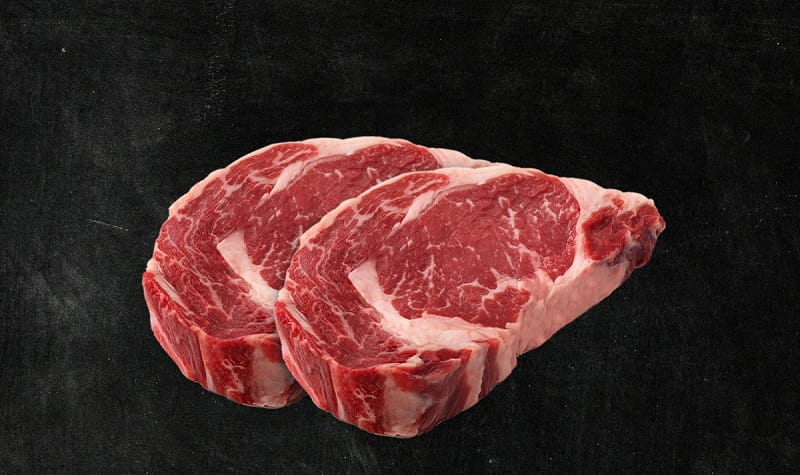
I have made some of these mistakes myself in the past. However, I have learned from my mistakes and improved my cooking skills. Today, I will share some common mistakes to avoid when cooking ribeye and striploin steaks.
Mistake #1: Not letting the steak come to room temperature
One of the most common mistakes that home cooks make is not letting the steak come to room temperature before cooking. The steak will cook unevenly when you take a cold steak out of the refrigerator and toss it onto a hot grill or pan. The outer part of the steak will cook faster than the inside, leaving you with a dry, overcooked steak. To avoid this, take the steak out of the refrigerator at least 30 minutes before cooking and let it come to room temperature.
Mistake #2: Not seasoning the steak enough
Another mistake that many home cooks make is not seasoning the steak enough. A good steak does not need a lot of seasoning, but it does need some. I like to keep it simple and use only salt and pepper. Season the steak generously on both sides and rub the seasoning in well.
Mistake #3: Using the wrong cooking method
Ribeye and striploin steaks are best cooked using high-heat methods like grilling, broiling, or pan-searing. If you use a low-heat method like slow cooking or braising, you will end up with a tough and chewy steak. Make sure to use the right cooking method to get the best results.
Mistake #4: Overcooking the steak
Overcooking the steak is a big no-no when cooking ribeye and striploin steaks. These cuts of meat are best-served medium-rare to medium. When you overcook the steak, it will become tough and dry. Use a meat thermometer to check the internal temperature of the steak. For medium-rare, the internal temperature should be between 130-135°F, and for medium, it should be between 135-145°F.
Mistake #5: Not letting the steak rest
After cooking the steak, many home cooks make the mistake of not letting it rest before slicing it. Letting the steak rest for a few minutes allows the juices to redistribute throughout the meat, making it juicier and more flavorful. Cover the steak with foil and rest for 5-10 minutes before slicing.
How To Cook Striploin Steak?
A perfectly cooked steak is something you can’t say no to. For this reason, I’ve decided to share my simple and foolproof recipe for cooking striploin steak.
First things first, let’s gather ingredients. Here’s what you’ll need:
- 2 lbs strip steak (2 steaks about 1 1/2 inches thick)
- Olive oil
- Sea salt and fresh cracked black pepper
- 4 cloves garlic, peeled and smashed
- 3 Tbsp butter
- 1/2 cup red wine
- Fresh rosemary, minced
Now, let’s get started.
- Step 1: Rub the steaks on both sides with olive oil and season with sea salt and pepper. Preheat your pan over high heat.
- Step 2: Add the meat to the hot pan and LEAVE IT in place so it can get fabulous caramelization. Cook for 3-4 minutes per side or until the meat is done to your taste. For a rare steak, cook to 125 degrees F, Medium Rare to 135 degrees F, Medium to 145 degrees F, Medium Well to 155 degrees F, and Well Done to 160 degrees F.
- Step 3: Add the butter and garlic to the pan and baste the meat a few times.
- Step 4: Remove the meat to a plate, tent with foil, and let rest for 5-10 minutes while you make a quick pan sauce.
- Step 5: For the pan sauce, deglaze the pan with the red wine and scrape up all the brown bits. Add the fresh rosemary and let simmer until the sauce is reduced by half.
- Step 6: Slice the steak, against the grain, into thin slices.
Once you have removed the meat from the pan, it’s time to deglaze the pan with wine. While stock or water can be used as a substitute for alcohol, I highly recommend using wine for the best flavor. As you cook the sauce, much alcohol will burn off, leaving a rich and delicious taste behind.
To add some depth to the flavor of your pan sauce, consider adding minced rosemary. Boil the sauce until it is reduced and thickened, and remove the garlic cloves for a more refined taste. Tasting the sauce and adjusting the seasoning as necessary is also important.
Once your pan sauce is ready, it’s time to drizzle it over your sliced steak. A mouth-watering, restaurant-worthy dish that you can easily make at home.
How To Cook Ribeye Steak?
Cooking a perfectly juicy and flavorful ribeye steak might seem daunting, but with the right techniques, anyone can do it. Here’s my go-to method for cooking a ribeye steak that will have your taste buds dancing joyfully.
First things first, let’s gather ingredients. Here’s what you’ll need:
- 1 24-ounce bone-in ribeye steak, 2-inch-thick
- Kosher salt and freshly ground black pepper
- 1 tablespoon canola oil
- 3 tablespoons unsalted butter
- 3 cloves garlic, smashed
- 3 sprigs of fresh thyme
- 2 sprigs of fresh rosemary
Now, let’s get started.
- First, it’s important to start with a good quality ribeye steak. I usually aim for a steak about 1-1.5 inches thick, with excellent fat marbling throughout. Before cooking, pat both sides of the steak dry with paper towels to remove any excess moisture.
- Next, season the steak generously with 1 1/4 teaspoons of salt and 1/2 teaspoon of pepper. If you like, you can also add any other seasonings you prefer, such as garlic powder or smoked paprika.
- Heat a medium cast iron skillet over medium-high heat until it’s boiling, which should take 1-2 minutes. Once the skillet is hot, add canola oil to it.
- Place the steak in the middle of the skillet and cook it, turning every 2-3 minutes, until a dark crust has formed on both sides. This should take about 12-14 minutes, depending on the thickness of your steak.
- Once the crust has formed, reduce the heat to medium-low. Push the steak to one side of the skillet and add butter, garlic, thyme, and rosemary to the opposite side. Tilt the skillet towards the butter and cook until the butter is foaming, which should take about 30 seconds to 1 minute.
- Using a spoon, pour the butter mixture over the steak and continue cooking for 1-2 minutes, turning it over once, until it reaches an internal temperature of 120 degrees F for medium-rare or until it’s cooked to your desired doneness.
- Once the steak is cooked to your liking, let it rest for 15 minutes before slicing. This will allow the juices to redistribute throughout the meat, ensuring a juicy and flavorful steak.
- Serve your perfectly cooked ribeye steak immediately, and enjoy!
FAQs
Why Is The Ribeye Steak Sometimes Called The “Cowboy” Steak?
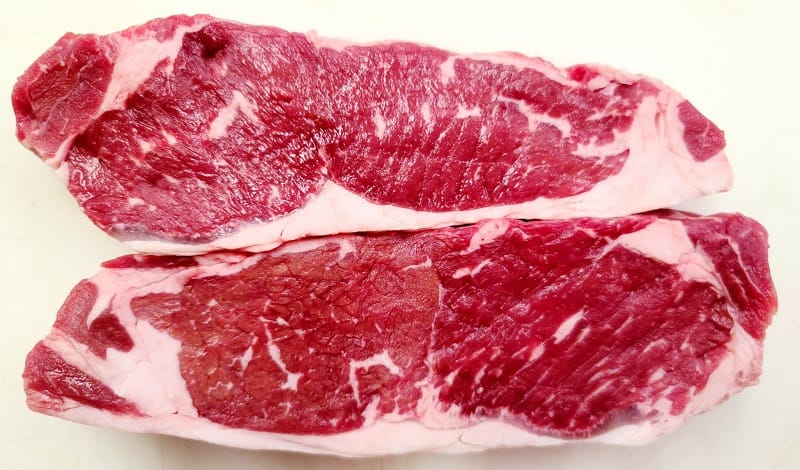
The ribeye steak is sometimes called the “cowboy” steak because of its popularity among the cowboys who had to butcher their beef while on the range. It is a bone-in steak cut from the rib eye, the large muscle group running along a cow’s back and above its rib cage. Each cowboy steak features a curved bit of bone that connects to the section of muscle known as the ribeye.
Leaving the bone in place gives an easy handle for flipping on the grill and adds flavor to the meat. However, some resources provide different definitions of cowboy steak. It can be any steaks taken from the short loin primal, like the t-bone or porterhouse, or any thick steak cooked over an open fire grill fueled by either wood or charcoal.
More often than not, the bone is even wrapped to preserve its color for presentation purposes. In terms of standardization today, the most common cowboy steak is a bone-in ribeye, cut between the rib bones and trimmed completely to the ventral edge of the longissimus dorsi with or without a frenched bone. Regardless of the rib bone length, it does not affect how the steak cooks or tastes.
What Is The Best Place To Buy USDA Prime Beef Steak?
When buying USDA Prime beef steak, several options are available to consumers.
- High-end grocery stores such as Albertson’s, Costco, Wegmans, and Whole Foods Market carry a small selection of wet or dry-aged Prime Steaks in their markets, though availability may be limited due to storage space.
- For those who don’t have access to these grocery chain stores, there are online delivery services specializing in beef and pork, like Snake River Farms, Agri Beef Company, and Chicago Steak Company.
- These companies offer a wider variety of prime cuts for customers, including American Wagyu and ribeyes, and use proper packaging methods like vacuum sealing and insulated coolers with dry ice or ice gel packs for overnight delivery.
While Whole Foods does offer prime cuts of beef, it’s important to note that Angus is a breed, not a grade, and while it naturally falls into the prime category, it is a different term than USDA Prime. Ultimately, the best place to buy USDA Prime beef steak will depend on individual preferences and budget.
Is It Better To Buy Steaks Online Or In-Store?
It is generally agreed that purchasing steaks online is the better option. Online meat companies source higher-quality meat and tailor their products to exact specifications, which is often ignored in most retail stores. This means that when it comes to great meat flavor, it starts with great meat.
Online meat companies also work closely with top-notch farms and facilities to purchase only the best meat, such as Prime and top-tier Choice products. In contrast, most chain retailers settle for less desirable and more cost-effective Choices and Select cuts.
While the price may influence people’s purchasing decisions, buying meat in bulk can save money at the butcher shop. Discounted packages at a butcher shop could offer better value than pre-packaged meats in supermarkets.
What Is The Source Of The Beef Used By Chophouse Steaks Online Butcher Shop?
Chophouse Steaks Online Butcher Shop sources all of their meat from trusted regional farmers with whom they have a direct relationship. They prioritize having a transparent relationship with their farmers and are able to provide specifics about each cut of meat they carry. Their trained butchers and team members can assist customers who require a specific cut.
They carry premium meats from animals raised in the best way possible according to their no antibiotics, growth hormones, and no artificial ingredients policy. The butchery is committed to supporting sustainable and humane agriculture, as it visits its farmers regularly. The animals are given open pastures to graze on and fed all-natural diets. The trained butchers use a whole animal philosophy, breaking down meat into as many usable parts as possible. The meat is better for consumers and better tasting too.
Does Kudacart Fine Food Plt Offer Both Ribeye And Striploin Steaks For Purchase?
The answer is yes; they do offer both. Kudacart Fine Food Plt is a renowned food emporium that offers a diverse range of high-quality meat products. The company prides itself in sourcing its meats from the finest producers, and the Ribeye and Striploin cuts are no exception. They are of the highest grade and are well-marbled, ensuring they deliver an exceptionally delicious taste to the discerning palate.
These cuts are available in-store and online, and customers can choose their preferred delivery method. Kudacart Fine Food Plt has an excellent reputation for the quality of its products, and its Ribeye and Striploin steaks stand out as some of the best available. Customers can rest assured that they are purchasing high-quality cuts of meat when they order from Kudacart Fine Food Plt.
Conclusion
In conclusion, ribeye and striploin are excellent cuts of steak that are sure to please any meat lover. Whether you prefer the tenderness and marbling of ribeye or the lean texture of striploin, you can’t go wrong with either choice. So next time you’re at a steakhouse or shopping for groceries, try both cuts and decide your favorite.
Now that you know Ribeye vs Striploin, we hope you’ll try this recipe! Let us know how it turns out by leaving a comment below.
References:
- https://www.livestrong.com/article/525800-nutrition-of-rib-eye-vs-sirloin/
- https://www.mychicagosteak.com/steak-university/where-can-i-buy-usda-prime-beef

Hey readers! Chip Holland here, and I’m a Manager of this website. My passion for writing about it only matches my passion for BBQ. Follow my blog for mouth-watering recipes, tips, and tricks for the perfect smoke, grill, and BBQ. I’m sure you won’t be disappointed!
